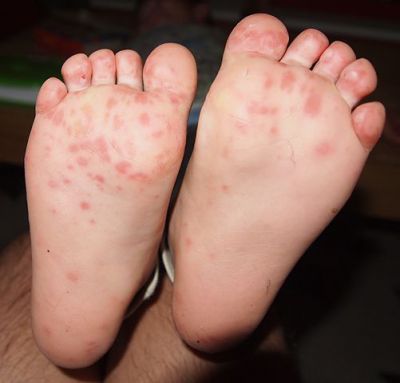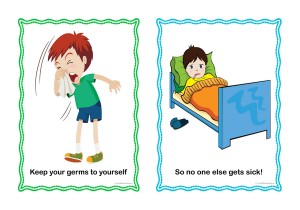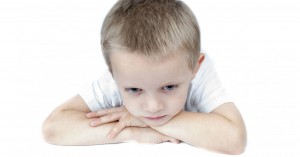Hand foot and mouth disease is a mild illness common amongst children who attend childcare. The most typical symptoms are blisters in around the hand, foot and mouth.
What is hand foot and mouth disease?
Hand, foot and mouth disease is typically mild illness caused by a number of enteroviruses, particularly coxsackieviruses. It is usually not a serious illness, and occurs mainly in children under 10 years of age but can also occur in older children and adults.
What are the symptoms?
- Enteroviruses such as coxsackieviruses may cause no symptoms at all or only very mild symptoms.
- When symptoms do occur, they include blisters that start as small red dots which later become ulcers. Blisters appear inside the cheeks, gums, and on the sides of the tongue, as well as on the hands and feet. In infants, sometimes blisters can be seen in the nappy area. Blisters usually last for seven to 10 days.
- Children can sometimes have a low fever, irritability, sore throat, tiredness, feel off colour and may be off their food for a day or two.
- Very rarely, the enteroviruses can infect the lining of the brain and spinal cord (known as viral meningitis) or other parts of the body.
How is it spread?
- Hand, foot and mouth disease is usually spread from person-to-person through faecal contamination (which can occur when changing a nappy or using the toilet and not properly washing hands afterwards), or spread through respiratory secretions (saliva, sputum, or nasal mucus) of an infected person. It is also spread by secretions from the mouth or respiratory system, and by direct contact with the fluid from blisters.
- With small children, sharing of toys that may have been in another’s mouth can also spread infection.
- It usually takes between three and five days after contact with an infected person before blisters appear. The viruses can remain in faeces for several weeks.
Who is at risk?
- The viruses that cause hand, foot and mouth disease are common and particularly affect children.
- Many adults, including pregnant women, are often exposed to them without symptoms. There is no clear evidence of risk to unborn babies from hand, foot and mouth disease. However, infected mothers can pass the infection onto newborn babies who rarely can have severe disease.
- Outbreaks may occur in child care settings.
How can it be prevented?
- Good hygiene is the best protection. Wash hands with soap and water after going to the toilet, before eating, after wiping noses, and after changing nappies or soiled clothing.
- Avoid sharing cups, eating utensils, items of personal hygiene (for example: towels, washers and toothbrushes), and clothing (especially shoes and socks).
- Thoroughly wash any soiled clothing and any surfaces or toys that may have been contaminated.
- Teach children about cough and sneeze etiquette: Cough and sneeze into your elbow (rather than your hands) or cover with a tissue.
- If you use a tissue to cover your nose and mouth, put the tissue in the bin straight away.
- Wash your hands afterwards with soap and water.
How is it diagnosed?
The doctor can diagnose hand, foot and mouth disease based on the symptoms. Laboratory tests are not usually necessary.
How is it treated?
- Usually no treatment is needed. Paracetamol will relieve fever and discomfort. Do not give children aspirin.
- Allow blisters to dry out naturally. The blisters should not be deliberately burst because the fluid within them is infectious.
- If the headache is severe, if fever persists, or if you are worried about other symptoms, consult a doctor.
Exclusion From Childcare
Children with hand, foot and mouth disease should be excluded from childcare until all the blisters have dried out.
Reference:
© New South Wales Ministry of Health for and on behalf of the Crown in right of the State of New South Wales










